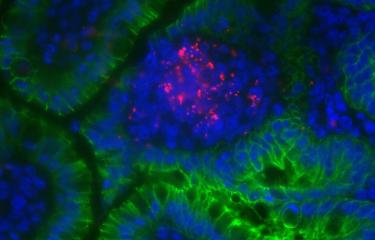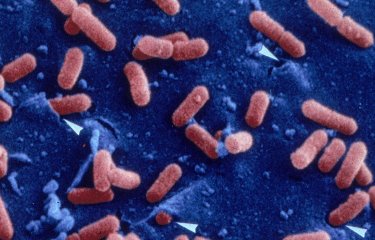A study conducted by Marc Lecuit from the Bacteria-Cell Interactions Unit (1) of the Institut Pasteur, which is directed by Prof. Pascale Cossart, has made it possible to uncover how the bacterium Listeria monocytogenes targets and cross the placental barrier in pregnant women. The crossing of the placental barrier leads to serious fetal infections, fetal death, miscarriages, premature births and neonatal infections.
The results of this study are published on-line by PNAS. They were obtained in collaboration with the Obstetrics and Gynecology Department of Washington University (Saint Louis, Missouri, United States), the Histopathology Unit of the Institut Pasteur, and the Pathological Anatomy and Cytology Department of Cochin-Port Royal Hospital (Public Assistance Hospitals of Paris).
Press release
Paris, april 6, 2004
Listeria monocytogenes. Widespread in nature (water, soil, plants, and animals), this bacterium can contaminate numerous foods: raw vegetables, ready-to-eat food, cheese, and deli products. Listeriosis primarily threatens pregnant women, fetuses, and newborns. Immunosuppressed and elderly persons are equally at risk. In these individuals, it is responsible for bacteremia, meningitis, and encephalitis. Antimicrobial therapy is effective in the majority of cases, but mortality still reaches 30% of the infected individuals. In healthy adults, the symptoms are generally milder and can be manifested as simple gastroenteritis.
The infection begins with the ingestion of food contaminated by Listeria monocytogenes that can then cross the intestinal barrier and reach blood circulation. Bacteria are then capable of passing through the blood-brain barrier and the placental barrier in pregnant women.
Marc Lecuit from the Institut Pasteur’s Bacteria-Cell Interactions Unit, directed by Prof. Pascale Cossart, has just demonstrated how the interaction between a protein from Listeria monocytogenes, internalin, and its cell receptor, E-cadherin, allow the bacterium to cross the human placental barrier.*
Internalin’s key role in human maternofetal infection was first suggested by the results of an epidemiological study conducted in collaboration with the National Reference Centre for Listeria.** In fact, across 300 clinical strains studied, all the bacterial isolates from pregnant women expressed this functional protein, while it was present in only 65% of strains from food.
To confirm the hypothesis of a crucial role for internalin in maternofetal infection, the researchers first examined placentas obtained from women with maternofetal listeriosis, and observed that bacteria adhered to the cells of the placental barrier and crossed the placental barrier. Bacterial invasion leads to an alteration of maternofetal exchanges at the placental level, resulting in miscarriages, premature births, and neonatal infections.
The researchers next showed that the internalin receptor of Listeria monocytogenes, E-cadherin, was expressed at the placental barrier level, and was accessible to bacteria present in the mother’s blood. Experiments using cultured placental cells or placental tissue cultivated ex vivo, lead to the demonstration that the infection of these tissues and the crossing of the placental barrier were dependant on the internalin - E-cadherin interaction.
This is the first time that the molecular mechanism allowing a pathogenic bacterium to cross the placental barrier is uncovered.
This team is also interested in the mechanism for crossing the blood-brain barrier. Its working hypothesis is that internalin could also play a role in infecting the central nervous system. Thus, internalin would be a key factor allowing listeria to target specifically three organs in humans: the intestinal tissue, the fetal-placental unit, and the central nervous system.
The work published today not only leads to a better understanding of the molecular determinants of the pathogenic properties of Listeria monocytogenes, but could also allow to target molecules of diagnostic or therapeutic interest at the level of maternofetal interface.
(1) Marc Lecuit, Institut Pasteur’s Bacteria-Cell Interactions Unit, fellow of the Department of Infectious Diseases and Tropical Medicine, Necker Hospital.
*Pascale Cossart’s team has identified internalin in previous studies, as well as its human receptor, E-cadherin, and demonstrated that the interaction between these two proteins allowed the bacterium to enter cells. In 2001, Marc Lecuit in Pascale Cossart’s team, in collaboration with Charles Babinet, head of the Development Biology Unit, had developed a transgenic mice model expressing human E-cadherin and discovered that the interaction between internalin and its receptor E-cadherin allows the bacterium to cross the intestinal barrier and reach blood circulation to produce a systemic infection there.
**At the Institut Pasteur, the National Reference Centre for Listeria is responsible for microbiological surveillance of human listeriosis. In epidemics, it participates in the operation linking the Health General Directorate, the Institut de Veille Sanitaire, the Food General Directorate, and the General Directorate of Competition, Consumption, and Repression of Fraud.
Sources
"Targeting and crossing of the human maternofetal barrier by Listeria monocytogenes: Role of internalin interaction with trophoblast E-cadherin" PNAS
Marc Lecuit (1), D. Michael Nelson (2), Steve D. Smith (2), Huot Khun (3), Michel Huerre (3), Marie-Cécile Vacher-Lavenu (4), Jeffrey I. Gordon (5), and Pascale Cossart (1)
1 - Bacteria-Cell Interactions Unit, Institut Pasteur, Paris
2 - Obstetrics and Gynecology Department, Washington University, Saint Louis, Missouri, United States
3 - Histopathology Unit, Institut Pasteur, Paris
4 - Pathological Anatomy and Cytology Department, Cochin-Port Royal Hospital, Public Assitance Hospitals of Paris
5 - Molecular Biology and Pharmacology Department Washington University, Saint Louis, Missouri, United States
Contact press
Presse Office
Nadine Peyrolo
01 45 68 81 47 - npeyrolo@pasteur.fr
Bruno Baron
01 44 38 91 30 - bbaron@pasteur.fr




